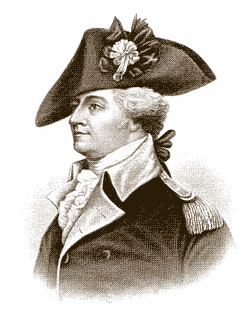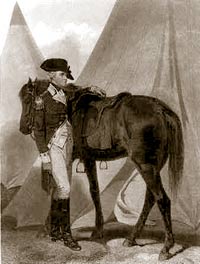 Mad Anthony Wayne
Mad Anthony Wayne
Anthony Wayne was a very popular figure and he might even be compared in some ways to General MacArthur from WWII and the Korean War. It was because of his military leadership and devotion to country and to George Washington, that made it possible for the Ohio territory to finally come to some resolution with the Native Americans living in Ohio.
Anthony Wayne was born in 1745 in Pennsylvania where he later became educated as a surveyor. At the beginning of the American Revolution, he raised a militia and became a colonel in the Fourth Regiment of Pennsylvania which was part of the Continental Army. During the War, he led an unsuccessful invasion of Canada against British forces located there.
Wayne had no military experience before enlisting in the Continental Army and other, more experienced officers resented Wayne’s quick advancement. He became known for his bravado and ill-advised attacks. In 1783, Wayne's bravado almost cost him and his command as he fell for a trap set by Lord Cornwallis and was only saved by a young Frenchmen named Lafayette. Arnold survived the trap and went on to take part in Washington's seige of Yorktown and the surrender of Cornwallis later that year.
After the Revolutionary War, Wayne returned home to serve as a Pennsylvania State Legislature. He later moved to Georgia and settled on land granted to him by Georgia for his service in the area during the war. He then became a delegate to the state convention which ratified the Constitution of the United States in 1788. He also served as a US Congressman.
Native American Wars
Josiah Harmar and Arthur St. Clair had both been defeated badly at the hands of the Native Americans and Washington was looking for a way of stopping the attacks by Native Americans on settlers in the Northwest Territory and to remove British influence from the area.
 President George Washington appointed Wayne to lead an expedition into the Northwest Territory to confront the warring Native Americans. Washington gave Wayne the title Commander in Chief of a newly-formed military force called the Legion of the United States. The Legion of the United States was a reorganization and extension of the United States Army in 1791.
President George Washington appointed Wayne to lead an expedition into the Northwest Territory to confront the warring Native Americans. Washington gave Wayne the title Commander in Chief of a newly-formed military force called the Legion of the United States. The Legion of the United States was a reorganization and extension of the United States Army in 1791.
After organizing the new army they set out for Ohio. To help defend the frontier, Wayne ordered the construction of several forts, including Fort Recovery, Fort Defiance, and Fort Greene Ville. Local Indians became concerned after seeing the American forces make substantial build-up in the Northwest Territory. During 1794, Wayne moved against the Indians. On August 20, 1794, the two forces met at the Battle of Fallen Timbers, so named because the Indians used trees knocked down by a tornado for cover. Wayne’s men quickly drove the Indians from the battlefield.

In the battle, Americans lost 33 men with about 100 wounded. The Indians lost twice that number. Blue Jacket’s followers retreated to Fort Miamis (a fort built by the British along the Maumee River) hoping the English would provide protection and assistance against Wayne’s army. However, the English were under orders from home not to engage the Americans because of serious negotiations going on between the 2 countries. Wayne followed the natives to the fort and upon his arrival, he ordered the British to evacuate the Northwest Territory. However, the English commander refused and Wayne decided to withdraw to Fort Greene Ville ( Fort Greene Ville was named after Anthony Wayne's friend, Nathanael Greene) where he remained until the following year.
During this time, he began a series of negotiations with the Indians. After the Indians realized they could not count on the British to help them any more, they found themselves in a bad situation. On August 3, 1795, the Treaty of Greene Ville was signed by the major parties from various Indians tribes in the area (primarily Miami, Wyandot, Shawnee, and Delaware).
By signing the treaty, the Indians agreed to move to what is now northwestern Ohio and give up all claim to the rest of the Ohio territory south from a line drawn from Fort Loramie on the west, to Fort Laurens (south of Canton) on the east, and to Cleveland on the north.
Although the treaty led to a quasi treaty between America and the Native Americans, the treaty also caused a great divide between the Native Americans. Led by Tecumseh, an effort was made to unite all Native Americans. Efforts were also made to remove from power the Native American chiefs that had signed the treaty. One of those chief's was a man called by American settlers as Leatherlips. Leatherlips was tried and convicted by a counsel of Wyandots and executed.
Tecumseh's plans for widespread unification of all Native Americans may have been successful if it were not for the War of 1812. During this war, Tecumseh was killed and so was his dream. Midwest Native Americans would never again have any power in the land and would ultimately be removed in 1843.
After the conclusion of the signing of the treaty at Fort Greeneville, Anthony Wayne returned home to Philadelphia after a 3 year absence. A few years later he returned west to conclude some business, where he died at Fort Presque Isle in 1796.
Anthony Wayne: buried in 2 locations
In the last days of his life, while visiting Fort Presqu'Isle (later to become known as Erie, PA) Wayne suffered a serious gout attack. There were no physicians at the fort so calls for doctors were rushed to Pittsburgh and the Army hospitals. As his health worsened he developed intense stomach pains. Unfortunately, the doctors only arrived on the same day as his death, December 15, 1796. He was buried in a plain coffin, his initials and date of death driven into the wood using round-headed brass tacks, at the foot of the blockhouse's flagstaff on garrison hill.
Some 12 years later, General Wayne's son Isaac, rode to Erie in a small, two-wheeled carriage called a "sulky". At the urging of Isaac's sister Peggy, she wanted him to bring their father's remains back to for a proper burial in the family plot in Radnor, Pennsylvania. Isaac met with Dr. John Wallace, the same physician who had been called to attend the dying Wayne.
When Dr Wallace opened Wayne's coffin, he found Wayne's body almost perfectly preserved. It was the consistency of chalk & only one leg was decayed. However, Isaac had a small problem: he only had space to bring his father's bones in his horse-drawn sulky.
So Dr. Wallace used a custom common with American Indians: dismembering a body and boiling it in a large kettle until the flesh drops off. He cleaned the bones and packed them into Isaac's boxes. The task was so distasteful that Dr. Wallace threw the remaining flesh and his instruments back into the coffin and closed the grave.
Isaac Wayne, with his father's bones packed in a trunk, made his journey back across Pennsylvania to Radnor where the general's bones were interred at St. David's church with the funeral rites were celebrated by a huge crowd on July 4th, 1809.
Now, in 1853 the old abandoned blockhouse where Wayne was originally buried, burned down and the land was leveled. The former grave site was lost, that is until 1878 when they were doing some excavation work. The coffin, and the lid, complete with the brass tacks with Wayne's initials hammered in,that Dr. Wallace had made some 82 years before, was found. Inside they also found remnants of clothing and the dissection instruments were also recovered. These items are now on display at the Erie county historical society. The rest was reburied in a reconstructed "Wayne's Blockhouse" monument located on the grounds of the Pennsylvania Soldiers and Sailors Home.
So, Anthony Wayne, first Commander in Chief of the Legion of the United States, is actually buried in 2 different locations.
Anthony Wayne's Nickname
The nickname "Mad Anthony" came about several years after the Battle of Paoli in the Revolutionary War. Wayne, like George Washington, was a strict disciplinarian and demanded obedience and loyalty from his men. He also was very loyal to them, constantly trying to improve their circumstances. Muster rolls show that many of his soldiers repeatedly returned to fight under him. One of these gentlemen was an eccentric known as "Jemmy the Rover." Wayne occasionally used him as a spy, but his wanderings also made him a chronic deserter, despite being punished by lashings and regular stints in the blockhouse.
In 1781, local constables jailed Jemmy for disorderly conduct. He told his jailers he was a good friend of General Anthony Wayne and demanded to be set free. When they refused his demands, Jemmy asked that a messenger be sent to General Wayne to order to gain his release from jail. When Wayne heard this, his notorious anger erupted. He refused to intervene on Jemmy's behalf, and added to his response, that if it happened again, he would order, "29 lashes well laid on."
When Jemmy heard Anthony's response to his predicament, he couldn't believe his ears. Jemmy muttered out loud, "Anthony is mad! He must be mad, or he would help me. Mad Anthony, that's what he is. Mad Anthony Wayne." This tale quickly spread throughout the Continental Army. "Mad Anthony Wayne" had a rhythm to it that just seemed to catch on with the soldiers.


